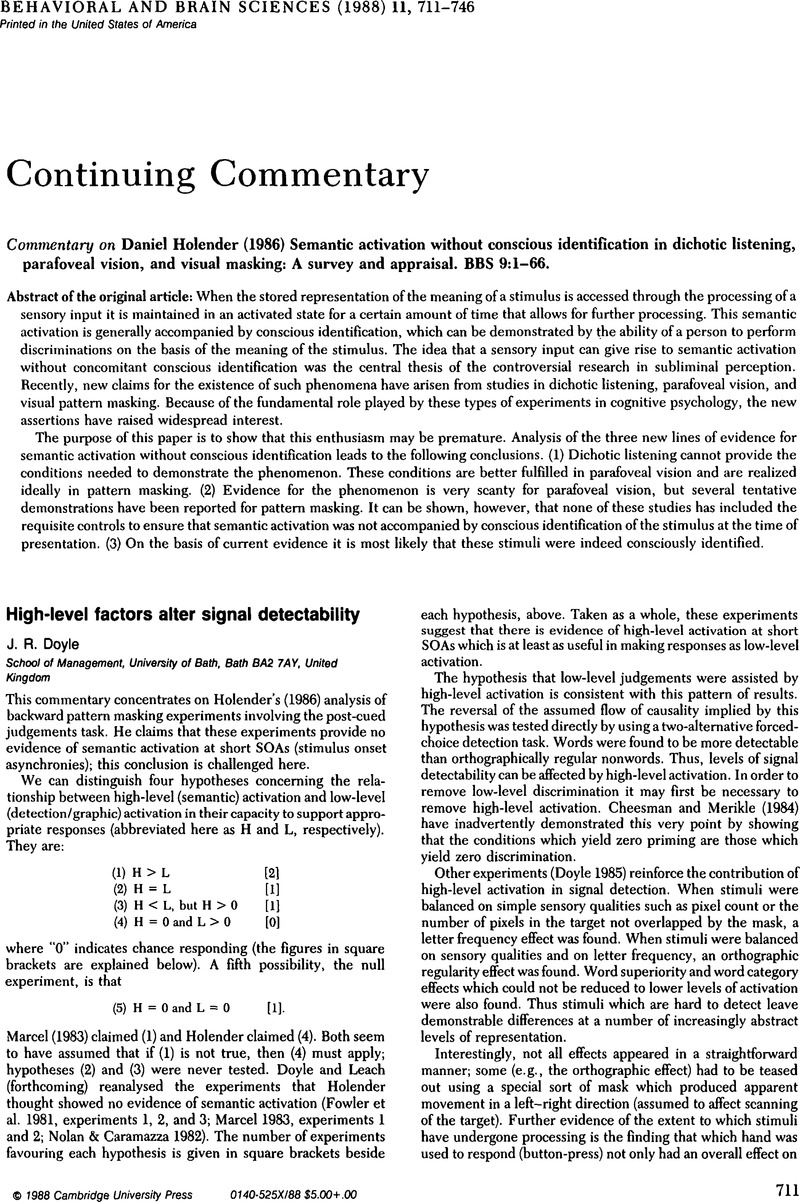Crossref Citations
This article has been cited by the following publications. This list is generated based on data provided by Crossref.
Economos, Judith
1991.
Observing protocol.
Behavioral and Brain Sciences,
Vol. 14,
Issue. 4,
p.
677.
Lloyd, Dan
1991.
Consciousness: Only introspective hindsight?.
Behavioral and Brain Sciences,
Vol. 14,
Issue. 4,
p.
686.
Gardiner, John M.
1991.
Memory with and without recollective experience.
Behavioral and Brain Sciences,
Vol. 14,
Issue. 4,
p.
678.
Inhoff, Albrecht Werner
1991.
Limits of preconscious processing.
Behavioral and Brain Sciences,
Vol. 14,
Issue. 4,
p.
680.
Spiegel, David
1991.
Dissociating consciousness from cognition.
Behavioral and Brain Sciences,
Vol. 14,
Issue. 4,
p.
695.
Klein, Raymond
1991.
Is consciousness information processing?.
Behavioral and Brain Sciences,
Vol. 14,
Issue. 4,
p.
683.
Wilson, Timothy D.
1991.
Consciousness: Limited but consequential.
Behavioral and Brain Sciences,
Vol. 14,
Issue. 4,
p.
701.
Wagstaff, Graham F.
1991.
No conscious or co-conscious?.
Behavioral and Brain Sciences,
Vol. 14,
Issue. 4,
p.
700.
Carlson, Richard A.
1991.
Consciousness and content in learning: Missing or misconceived?.
Behavioral and Brain Sciences,
Vol. 14,
Issue. 4,
p.
673.
Stanovich, Keith E.
1991.
Damn! There goes that ghost again!.
Behavioral and Brain Sciences,
Vol. 14,
Issue. 4,
p.
696.
Libet, Benjamin
1991.
Conscious functions and brain processes.
Behavioral and Brain Sciences,
Vol. 14,
Issue. 4,
p.
685.
Block, Ned
1991.
Evidence against epiphenomenalism.
Behavioral and Brain Sciences,
Vol. 14,
Issue. 4,
p.
670.
Navon, David
1991.
The function of consciousness or of information?.
Behavioral and Brain Sciences,
Vol. 14,
Issue. 4,
p.
690.
Dagenbach, Dale
1991.
On the premature demise of causal functions for consciousness in human information processing.
Behavioral and Brain Sciences,
Vol. 14,
Issue. 4,
p.
675.
Mandler, George
1991.
The processing of information is not conscious, but its products often are.
Behavioral and Brain Sciences,
Vol. 14,
Issue. 4,
p.
688.
Kinsbourne, Marcel
1991.
Velmans's overfocused perspective on consciousness.
Behavioral and Brain Sciences,
Vol. 14,
Issue. 4,
p.
682.
Schaeken, W.
and
d'Ydewalle, G.
1991.
Isn't the first-person perspective a bad third-person perspective?.
Behavioral and Brain Sciences,
Vol. 14,
Issue. 4,
p.
692.
Bowers, Kenneth S.
1991.
(Un)conscious influences in everyday life and cognitive research.
Behavioral and Brain Sciences,
Vol. 14,
Issue. 4,
p.
672.
Mangan, Bruce
1991.
Epi-arguments for epiphenomenalism.
Behavioral and Brain Sciences,
Vol. 14,
Issue. 4,
p.
689.
Shevrin, Howard
1991.
A lawful first-person psychology involving a causal consciousness: A psychoanalytic solution.
Behavioral and Brain Sciences,
Vol. 14,
Issue. 4,
p.
693.


